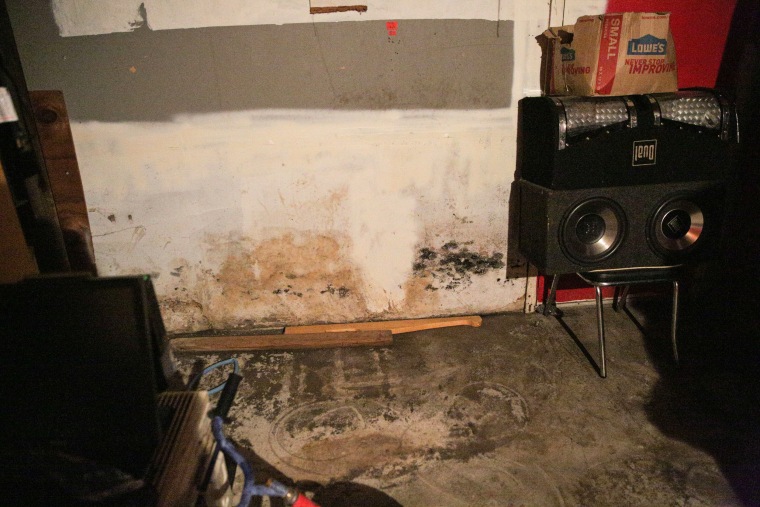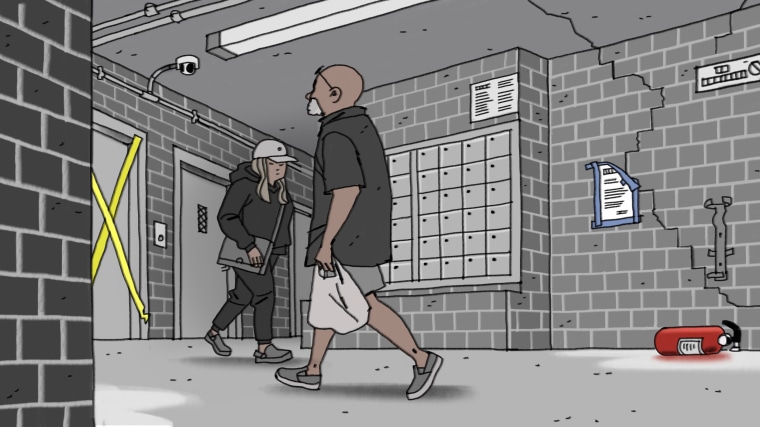The Department of Housing and Urban Development has backed away from new health and safety requirements for public housing that would require fire extinguishers, a minimum number of electrical outlets and other measures intended to protect residents from serious and potentially life-threatening hazards, according to the latest draft of the new standards.
Housing industry groups had urged HUD to ease some of these requirements, saying they would be too burdensome for landlords — alarming some tenant advocates who were caught off guard by the recent changes.
“It was surprising because we thought they were moving in a positive direction in a lot of ways. So it was disappointing that there was a retrenchment,” said Michael Kane, executive director of the National Alliance of HUD Tenants, an advocacy group. “The stronger version is important for people's health and safety.”
The standards are part of a sweeping, yearslong overhaul that aims to strengthen HUD’s inspection system for federally subsidized housing, including traditional public housing, Section 8 rentals and homes for older people with low incomes.
Under the new inspection system, which is still under development, the agency has significantly expanded the number of severe hazards that landlords must fix quickly, put more emphasis on the condition of residential units than building exteriors and added a slew of new safety and health requirements that tenant advocates have broadly supported. Since last year, however, HUD has also eliminated or relaxed some stricter proposed inspection standards in a number of key areas, according to NBC News’ analysis of the draft proposals.
Originally, HUD proposed requiring at least one fire extinguisher per floor, according to the first draft of the standards released in July 2020, calling it a “life-threatening issue.” The agency has since eliminated the requirement and will only consider fire extinguishers to be missing if there is “evidence of prior installation,” such as a bracket on the wall, according to the latest draft of the standards, released in April.
HUD similarly removed a proposed requirement for a minimum number of working electrical outlets in bedrooms, living rooms, kitchens and bathrooms that was included in the initial draft. A minimum outlet standard is required by many cities and states as part of their building codes to reduce the risk of electrical fires from overloaded outlets, and to minimize the use of extension cords.
The agency also loosened requirements for fans and windows in bathrooms — critical to preventing mold — and ground fault circuit interrupters for outlets near water, which are proven to reduce the risk of electrocution but are not always required by local authorities in older housing. HUD’s proposed rules now allow for “alternate means of dehumidification” for bathrooms and “outlet protection methods that include, but are not limited to” GFCI protection. (It’s not clear what other protection methods the HUD rule refers to.)
HUD denied weakening protections for residents and said providing safe and sanitary housing is a top priority for the Biden administration.
The initial draft standard for fire extinguishers had been misinterpreted, so HUD clarified it in the following version, the agency said. Other standards were modified after officials determined that the originally proposed changes would require additional rule-making to be implemented. The agency stressed that the new system is still under development.
“HUD will continue to make updates to the standards as necessary before their final publication,” Ashley Sheriff, an acting deputy assistant secretary for HUD's Real Estate Assessment Center, said in a statement. She added the agency would be guided by input from thousands of demonstration inspections as well as “substantial additional dialogue with residents, property owners and agents, public housing agencies and other stakeholders.”
But as they currently stand, some of HUD’s proposed requirements fall short of the minimum standards for residential housing set by the International Code Council and the National Fire Protection Association, which develop public safety codes that many state and local governments have adopted.
Do you have a tip about HUD inspections, health and safety hazards or living conditions in HUD properties? Contact us.
When informed of the changes by NBC News, advocates for tenants and safe housing urged HUD not to weaken health and safety standards in ways that could endanger the 5 million families across the country who live in federally assisted housing.

Ruth Ann Norton, president and CEO of the Green and Healthy Homes Initiative, a nonprofit organization that promotes safe housing, worried that the most vulnerable tenants could be most at risk.
“If we don't deal with poor standards, we will continue the practice of rolling downhill, and communities of color and low-income households will bear the brunt of it,” Norton said. “That doesn't mean dumb them down or lighten them up until everyone agrees.”
The changes to the proposed standards follow an outcry from landlords, property managers, housing authorities and industry groups about the cost of complying with some of the new requirements, especially in older buildings, which could force landlords to make difficult choices.
“You have windows that have never been replaced, roofs have never been replaced, and they’re not supposed to last 50 years — those are the tradeoffs,” said Seth Embry, a former policy analyst for the Public Housing Authorities Directors Association, an advocacy group for public housing officials, who now works for an Alabama-based housing authority.
Still, both tenant advocates and housing providers have been broadly supportive of the overhaul, which began under the Trump administration and is considered long overdue. HUD relies on inspection standards and protocols that were created decades ago, using a system dating back to the 1970s for Section 8 housing and a system from the 1990s for public housing. For years, the federal inspection system has been under heavy scrutiny as low-income HUD residents have experienced toxic mold, infestations, crumbling ceilings, broken heaters and deadly exposure to fire and carbon monoxide, among other hazards.
After a 2019 fire in Minnesota killed five public housing residents, state authorities blamed a lack of sprinklers and fire doors that failed to close properly, among other factors, advising that fire doors never be propped open. The draft HUD standards require fire doors to be undamaged and functional, under changes that are stronger than the current requirements, but do not prohibit them from being propped open — something that the agency told NBC News it would clarify in the next version of the standards.
The goal of the HUD inspection overhaul is to rewrite the rules to prioritize “the health and safety of residents,” rather than the physical appearance of otherwise safe items that have been disproportionately emphasized during inspections, such as cosmetic damage to the outside of buildings, the department said. The Trump administration released the first draft of the new standards last year and solicited feedback from the public. The inspection overhaul has continued under the Biden administration, led by HUD’s Real Estate Assessment Center.

Housing industry groups have often blamed poor conditions on a steep decline in federal funding over decades, estimating a $70 billion shortfall in capital needs and repairs nationwide. While President Joe Biden proposed investing $40 billion to rehabilitate public housing in his original infrastructure plan, the funding was excluded from the bipartisan agreement currently under consideration.
Some housing providers have raised concerns that some of the stricter requirements that HUD has been considering could deter private landlords from participating in programs like Section 8, which provides rental subsidies but limits the rent that landlords can charge. In recent years, thousands of landlords have left the program — and some have singled out burdensome inspections and administrative costs as major barriers. The new inspection system does not currently include additional money to help landlords comply, though HUD said the agency would consider making a request later in the process.
“To hold older properties to the same standards of recent buildings is beyond unfair and it would be a financial burden,” the Housing Authority of the City of Los Angeles wrote to HUD in March. “Some owners with older properties may decide not to participate if we are requiring significant upgrades to their units in order to pass inspection, upgrades that they are not required to perform if they rent to someone in the private market. This is very concerning, we are facing an extreme housing shortage in our city.”
The housing authority later emphasized that it supported the broad goals of HUD inspections. “We didn't say to not inspect for health and safety issues but to factor in property ages,” a spokeswoman told NBC News.
HUD-assisted housing is subject to regular federal inspections as a condition for receiving taxpayer funding. While HUD properties must also comply with state and local codes, standards vary widely from place to place, which is why many advocates for tenants and safe housing have urged the agency to adopt stricter, uniform rules for all subsidized properties.
HUD is currently asking for public feedback on the latest draft of its standards, and the next version is expected to be released in early 2022, after the inspections are tested in the field.
Tenant advocates have praised the agency’s heightened focus on the condition of individual units, as well as the greater attention to toxic hazards like mold, which Kane described as “almost an epidemic in these buildings.” HUD also pointed to plans to include resident surveys as part of the inspection process, which some industry groups have opposed.
The recent changes, however, mean more of HUD’s draft standards fall short of codes established by some leading public safety organizations. The National Fire Protection Association’s fire code, for example, recommends requiring at least one fire extinguisher per floor for all residential buildings other than one- and two-family homes to enable residents to contain small fires before they spread.
“You never want them to be too far, and you want them to be on your way out of the building,” said Brian O’Connor, an engineer for the organization.
The International Code Council has pushed HUD to adopt the council’s standards for property maintenance — which are used in 36 states and over 1,000 U.S. cities — pointing out that they are stronger in many areas than what HUD is currently proposing. That includes stricter requirements for a minimum number of outlets, electrical circuit protection and bathroom ventilation.
“In order to have a more systemic update to the minimums, there's going to have to be leadership attention shown to the issue,” said Gabe Maser, vice president of government relations for the International Code Council. He described the group’s recommendations as the “bare minimum” for ensuring safety and urged HUD to reconsider its approach.
“Folks have worked with the existing standards for decades, and something is going to have to change,” Maser added.
The agency denied that it was taking a cautious stance toward its inspection overhaul.
“HUD will take whatever bold and meaningful action that it takes to make sure that there is decent, safe and affordable housing,” said Lopa Kolluri, principal deputy assistant secretary for HUD’s Office of Housing. “We want to make sure that vulnerable populations and communities of color are not living in substandard conditions.”
At the same time, the agency stressed that other parties are also responsible for oversight, as landlords will be required to conduct yearly self-inspections under the newly proposed system, and HUD requires all properties to comply with state and local laws.
“We're not the only folks that are inspecting properties,” Sheriff said.

